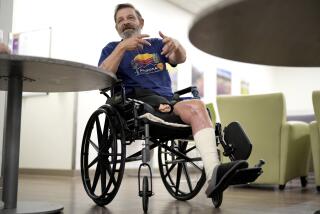BODY WATCH : Slow the Burn : Saving yourself from skin cancer isn’t difficult. Think sunscreen, sunscreen, sunscreen.
- Share via
A lot of us are hellbent for the outdoors even though 1 million cases of skin cancer will crop up this year, according to the American Academy of Dermatology. So we asked Dr. Edward L. Tobinick, a dermatologist and assistant clinical professor of Medicine at UCLA and director of the Skin Cancer Institute, for some guidance.
“To tell someone not to go in the sun between 10 a.m. and 3 p.m. every day of their life is too restricting,” he says. After all, being out in the sun makes most people feel better.
“I prefer people to be shade bathers,” Tobinick says. “It’s not safe to lie out in the sun.” But he knows that many people are going to play in the sunshine willy-nilly.
Here’s a summer tip sheet.
* Begin by “designing your protective program in accordance with your needs, lifestyle and genetic predisposition,” Tobinick says.
If you are dark-skinned and don’t plan on being outdoors for more than an hour, then you probably don’t need to protect yourself. If you’re going to be out for more than an hour, use sunscreen, especially on the palms of the hand, soles of the feet and under the nails.
If you are fair-skinned, sometimes burn and are going to be outside for 1 1/2 hours midday, use SPF 30 sunscreen.
* Regardless of skin type, use SPF 30 and reapply waterproof SPF 30 if you sweat excessively or participate in water sports.
* Don’t forget to cover your back with sunscreen when swimming.
* A white T-shirt lets in about half of the sun’s rays; you still need sunscreen.
* Put sunscreen on no less than five minutes before you go outside. You also want to make sure the sunscreen is dry before you swim or play any sport that makes you sweat.
* You don’t need to goop on sunscreen, but don’t be stingy either.
* Sunscreen is more effective if you apply it over a moisturizer.
* Moisturize your face with a cream that is no less than 15 SPF; some lipsticks and glosses contain sun protection.
* Do not use skin products with alpha hydroxy acids the night before or the day you go outside.
* Sunscreen creams are more cost-effective than sprays.
* Smear sunscreen on your hands and forearms when you’re commuting.
* Check the ultraviolet level. An index is reported daily in weather updates.
* Apply sunscreen on overcast days; 60% of ultraviolet rays go through clouds. Four to five hours outside on a cool, cloudy day is the equivalent of two hours in the sun.
* Wear a hat or a visor. A hat with a four-inch brim is advisable for everyone.
* Wear sunglasses with 100% UV block to protect eyelids and eyeballs. The National Institute for Occupational Safety and Health found that the best sunglasses (with UV protection) cost $1.50 more than the worst. Sunbeams cause eye disease and the whites of the eyes to yellow.
* Contact lenses with ultraviolet protection do not protect the entire eyeball.
* Do a self-check skin exam monthly. See a physician without delay if you notice any changes in the size, shape or color of moles, blemishes or birthmarks; a sore does that not heal, or red scaly patches.
* Additional sources: American Cancer Society, American Academy of Dermatology.
(BEGIN TEXT OF INFOBOX / INFOGRAPHIC)
SUN SMARTS:
1) 0.35-ounce lip protection, SPF 15......$ 1.29
2) 1.70-ounce face cream, SPF 15........... 9.35
3) 4.0-ounce waterproof sunscreen, SPF 30.. 5.49
TOTAL $16.13
What’s Your Skin Type:
Skin types, ranging from very fair (Type 1) to very dark (Type 6), are pegged according to reactions to sunshine. These characteristics can help you guage your threshold:
Type 1 BURNS: Always. TANS: Never Type 2 BURNS: Usually. TANS: Occasionally / Slightly Type 3 BURNS: Occasionally. TANS: Usually Type 4 BURNS: Rarely. TANS: Always Type 5 BURNS: Unlikely TANS: Always Type 6 BURNS: Generally doesn’t. TANS: Always


